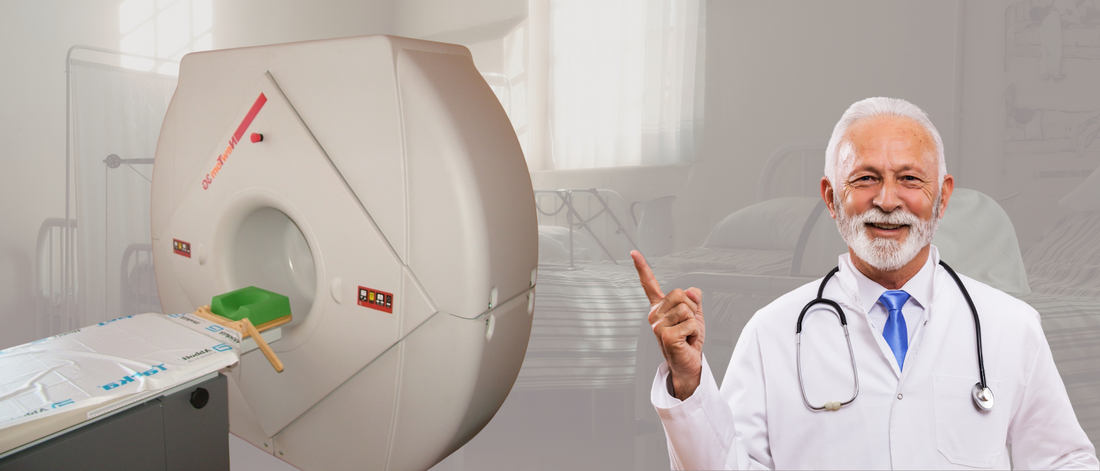Origin of CBCT:
In the dynamic realm of dentistry, technological advancements have always been catalysts for enhancing diagnostic precision and patient care. Among these innovations, Cone Beam Computed Tomography (CBCT) stands out as a game-changer that has reshaped dental practices worldwide since its debut in the European market in 1996. This comprehensive blog explores CBCT's extensive reach, its diverse ecosystem of manufacturers, the technical innovations that have redefined dental diagnostics, and the profound implications of this technology on the future of oral healthcare.
The Birth of CBCT:
The journey of CBCT's transformation of dentistry started with the groundbreaking NewTom 9000, the pioneer of commercial CBCT systems. Its introduction in Europe in 1996 was a watershed moment for dental imaging technology. In 2001, it crossed the Atlantic to reach the USA, further extending its global influence.
The i-CAT Classic Model:
The CBCT revolution gained momentum with the introduction of the early i-CAT Classic model. This cutting-edge technology provided dentists with a three-dimensional view of the oral and maxillofacial regions, transcending the limitations of traditional two-dimensional radiography. This marked the beginning of a new era in dental diagnosis and treatment planning.
Diversity of Manufacturers:
One striking aspect of the CBCT revolution is the diversity of manufacturers in the market. Companies from around the world have contributed to the evolution of CBCT technology, each bringing their unique innovations and perspectives. Major players such as Planmeca, Carestream Dental, PreXion, NewTom, Sirona, and Kavo have expanded CBCT's global footprint. Additionally, smaller, specialized manufacturers have made their mark with niche solutions catering to specific dental disciplines.
Global Impact:
The profound impact of CBCT technology on global dentistry is undeniable. This influence transcends geographical boundaries and has resulted in a paradigm shift in dental practices across continents.
- Europe: The birthplace of CBCT, Europe has consistently been at the forefront of adopting this technology. Its widespread use in European dental practices has elevated the standard of care across the continent.
- North America: CBCT's introduction to the USA in 2001 sparked a wave of innovation in dental practices across the country. It rapidly became an indispensable tool for practitioners, enabling them to offer more precise and personalized treatment options to their patients.
- Asia: The adoption of CBCT in Asian countries has been remarkable, with a growing number of dental professionals harnessing its capabilities. This technology has not only improved patient outcomes but also elevated the education and training standards in the region.
- Rest of the World: CBCT's influence is not limited to the continents mentioned above. Dental practitioners in Africa, South America, and other regions have also embraced this transformative technology, with its ripple effect being felt in dental communities globally.
Technical Innovations:
CBCT's impact on global dentistry is not limited to its introduction; it is characterized by continuous technical innovations that have enhanced diagnostic capabilities. Some of these innovations include:
- Image Quality Enhancement: Manufacturers have made significant strides in improving image quality, reducing artifacts, and minimizing radiation dose. High-resolution CBCT scans now offer unparalleled clarity.
- Software Advancements: Advanced software solutions allow for precise image manipulation, facilitating treatment planning with unmatched accuracy. Features like 3D image reconstruction, virtual implant placement, and airway analysis have become integral to CBCT software packages.
- Application Expansion: CBCT has evolved beyond traditional dental procedures. Its applications now encompass oral surgery, orthodontics, endodontics, periodontics, and more. This versatility has made CBCT indispensable in various dental specialties.
- Integration with CAD/CAM: CBCT technology seamlessly integrates with computer-aided design and computer-aided manufacturing (CAD/CAM) systems, enabling more efficient and precise restorative dentistry.
The Future of CBCT:
The future of Cone Beam Computed Tomography (CBCT) in dentistry holds immense promise and potential for transformative advancements. As technology continues to evolve, CBCT is set to play an even more pivotal role in shaping the landscape of dental diagnostics and patient care.
- One of the most exciting prospects on the horizon is the continuous improvement of CBCT's imaging capabilities. Dental practitioners can anticipate images of unparalleled precision and clarity, allowing them to visualize even the tiniest anatomical structures with exceptional detail. This heightened level of accuracy will be instrumental in early disease detection, precise treatment planning, and improved patient outcomes.
- Addressing concerns about radiation exposure remains a paramount concern. The future of CBCT technology is likely to incorporate cutting-edge dose reduction techniques. These innovations will not only prioritize patient safety but also maintain the diagnostic quality of images, striking a crucial balance between precision and protection.
- Artificial intelligence (AI) is expected to become an integral part of CBCT technology. Machine learning algorithms will assist in the interpretation of CBCT images, enabling quicker and more accurate detection of abnormalities. The integration of AI will not only enhance efficiency in dental practices but also elevate diagnostic accuracy to new heights.
- The versatility of CBCT is set to expand even further. While it has already made significant inroads into various dental specialties, such as oral surgery, orthodontics, and endodontics, the future will likely see its integration into new areas of dentistry. This expansion of clinical applications will unlock innovative approaches to diagnosis and treatment, enhancing the overall quality of patient care.
In summary, the future of CBCT in dentistry holds a tapestry of technological advancements that will empower dental professionals to provide more precise, personalized, and efficient care to their patients. As CBCT continues to evolve, its impact on the field will be nothing short of transformative, solidifying its position as a cornerstone of modern dental diagnostics and patient-centric healthcare.

